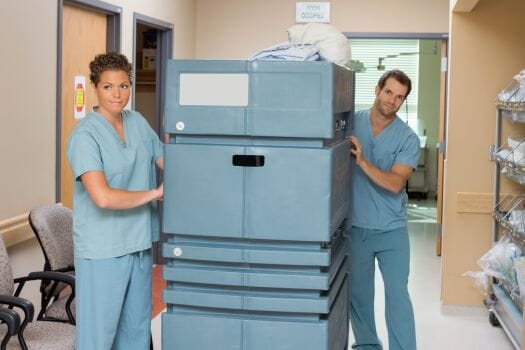How To Prepare for a Regulatory Survey
Support Services: Preparing for a Regulatory Survey
Few words strike fear in the hearts of hospital employees like “Surveyors are in the building.” Unannounced, a group of strangers just entered your place of work to judge your operation, they will probably be there several days, and everybody’s stress level is high. Vacations are canceled, meetings put on hold, and general day-to-day operations are up-ended. When my wife and I were planning our wedding, we opted to schedule it after our triennial Joint Commission Survey (we were both directors at the same hospital). That’s how serious surveys can be. It is a harrowing time that hopefully only happens every three years, but you can avoid some of the sweat and sleepless nights if you know what you are preparing for and how to do it.
Who are these people and why are they in my hospital?
Surveyors come in lots of shapes and sizes. The American Hospital Association came out with a useful and overwhelming chart in 2017 showing the different regulatory agencies that oversee hospitals. It is a daunting chart to be sure, but instead of getting bogged down in all the different agencies and particulars of who does what, let us instead look at the major ones that affect Support Services and largely encompass the rest.

Figure 1: the hospital regulatory framework
The Center for Medicare and Medicaid Services (CMS) is the largest and most direct regulator of hospitals. Every hospital that accepts Medicare or Medicaid patients must abide by their regulations, which are called Conditions of Participation (CoP). However, while CMS is extremely large, they do not survey on site very often or with a defined schedule. They mostly delegate that responsibility to what are known as “deemed status” agencies who offer accreditation based on the CMS CoP. The Joint Commission (TJC), Det Norsk Vertias (DNV), the Center for the Improvement of Healthcare Quality (CIHQ), and others are examples of deemed status agencies, meaning their accreditation surveys meet or exceed the CMS CoP. That said, CMS does reserve the right to perform their own check survey on any accredited hospital just to make sure the agency is being thorough enough. They have been using this right with increasing frequency over the past few years.
Accreditation agencies are hired by the hospital to serve in both a regulatory and consultative capacity. Think of them as parents; they are invested in your success and want to help you be your best, but they are also responsible for making sure you do things right. They are at your facility first and foremost to ensure the safety of the patients.
Once inside the building surveyors can essentially go anywhere in the licensed space, though different rules apply to different space types. This is usually accomplished through a “tracer”; this is when the surveyor will follow a patient from entry into the hospital to the different departments involved in their care through until discharge. Surveyors will review charts, talk to frontline staff, and observe the environment as they do this. To be clear, this is done virtually through chart review and staff interviews, surveyors do not literally follow a patient everywhere through their stay. They can also request the HR file of any employee who served a patient involved in a tracer, or they may request a random sampling of files, such as your most senior and least senior employees. In addition to tracers, surveyors will meet with department heads and committees within the hospital, review required plans and documents, and do a physical inspection of the Fire & Life Safety systems.
How to prepare for a survey
The best way to prepare for a survey is to never stop preparing for a survey. Where people get caught is often when they feel like they are “out of the woods” and begin to get lax on compliance or distracted by other things. In reality, the laws are always the laws, not just during a survey window. However, managers often change during that three year cycle, so you may find yourself in a new role when surveyors come knocking. If you follow these guidelines, you should have a much easier time.
But before we get into the specifics, we need to get into the right mindset. First, you need to learn to think like a surveyor. A surveyor will not assume everything is fine, he/she will dig deeper and deeper until an issue is found. A surveyor’s job is to find failures in the process, so that needs to be your focus. You need to look at the things you seldom inspect, open the doors you never open, and talk to those problem employees so that you can find the issues and fix them before the surveyors do. If you are a director, you need to get out of your chair and start spot-checking the things a supervisor usually does, like logs, quality inspections, and direct observations of your employees doing their jobs.
You also need to take time for yourself. I know that sounds impossible considering everything else that is going on, but you need to get the right amount of sleep, eat well, and keep a level head. Panic is contagious and stress reactions are toxic to your team. Presenting as calm, poised, and confident will make your team more comfortable when things begin. Remind yourself of how you are presenting when you do your rounds.
Step 1: Familiarize yourself with regulations
This one should be obvious, but I still find many managers and directors who have never actually read the accreditation standards of their deemed status agency. If you do not have a copy of the current standards, ask your Quality or Licensing department. The Joint Commission charges for their books of standards, so you may need to borrow a copy, but do not let that stop you. Remember, these are all based on the CMS Conditions of Participation, which you can look up for free online.
Granted, there are a lot of regulations and you do not need to know all of them, but you do need to know the ones that apply to your department. If you work in a department like Pharmacy, there is a whole set of standards that apply specifically to you (Medication Management), but you also need to be familiar with standards in Human Resources around training, Infection Prevention and Environment of Care around cleaning, and Emergency Management about what to do in a disaster. If you work in a department without its own chapter, like Environmental Services, you will need to look at related chapters your department impacts.
Now here is the bad news. The standards are merely a framework that tie together underlying regulations. Remember all those agencies from the spaghetti diagram at the beginning of the article? They all have rules, too. The Joint Commission or other accreditation providers will usually reference state and local regulations or other professional specialty organizations, such as the Association of periOperative Registered Nurses (AORN), the Center for Disease Control, or the National Fire Protection Association (NFPA), just to name a few. You should be able to obtain the AORN standards for cleaning from your Nursing or Infection Prevention departments and the NFPA Life Safety Code from your Facilities department.
Your next responsibility is to check your state’s licensing regulations, which are usually designated as a “Title” or “Chapter” in the state code of regulations. For example, California has Title 22, which is the section of the Code of California Regulations that governs Social Security, chapter 5 of which covers hospitals. You can usually find these by entering “[state] licensing regulations for hospitals” into Google. These regulations are normally significantly less comprehensive than Federal CMS regulations, but they are also usually far more straightforward in terms of expectations and they contain more specifics on how things should be done.
Now that you have all of these together, you will want to come up with a “cross-walk” document, a matrix that puts similar regulations from the different bodies side-by-side so that you can ensure you are compliant with all of them. While this is tedious work, it really only needs to be done once and then it can just be updated as standards change, but it is extremely effective in ensuring you do not have holes in your compliance program.
Step 2: Environmental Rounds
Take a break from the research and go see what your facility looks like. This is the time when it counts to pull the linen and medication carts away from the walls and look in the corners. It might be a pain to move that Omnicell, but it’s better to know what is behind it now rather than after a surveyor finds it first. Remember, surveyors are there to find issues, and one of the easiest things to find are environmental issues like dust bunnies, incomplete logs, unattended chemicals, etc. You should be rounding with the same sense of purpose; you want to find every problem before anyone else.
The most common Environmental Services issues I see when I’m helping facilities prepare for surveys are unattended/unlocked housekeeping carts, blocked or propped fire doors, obstructed egress corridors, obstructed pull stations and fire extinguishers, and safety & access issues around the compactors. Another common issue is overloaded combustible materials in a single smoke compartment from containers that are too large. A smoke compartment is an area where smoke can accumulate in a fire, but is relatively contained. This is usually accomplished by having 2-hour rated fire doors that form a barrier and keep smoke and fire in a single area. Up until 2018, the maximum size of a smoke compartment was 22,500 sqft and the maximum size of a trash or soiled linen container in that space was 32 gallons. Anything greater than 32 gallons had to be placed in a “hazardous area,” which has additional protections in case of a fire. Soiled Utility rooms should – but don’t always - meet the requirement for “hazardous area.” Sometimes hospitals will change the use of a room without changing the room to meet code. After 2018, though, smoke compartments for new and some existing hospitals were raised to 40,000 sqft and containers for recycling/shredding ONLY were raised to 96 gallons. Trash and soiled linen hampers are still limited to 32 gallons.
The above paragraph is illustrative of how some environmental requirements are simple and obvious, such as a clean facility free of visible dirt, while others are exceedingly detailed. Gone are the days when all you had to worry about was cleanliness. Knowing the detail is what separates the average leader from the exceptional one.
Step 3: Staff Rounds
Back in the 80’s and 90’s, surveyors would show up at a hospital and ask for a copy of their policies; as long as the policy existed, the standard was met. These days, surveyors will come in and both observe your staff directly to see if they are following policy, as well as quiz them on whether or not they know what to do. For example, they may ask a housekeeper what his or her response should be in a fire, what the five moments are for hand hygiene, how long the dwell time on their disinfectant is, or to name a National Patient Safety Goal. It is perfectly permissible for a housekeeper to reference a badge buddy, look at a poster, or check a surveyor guide, but it is not permissible for a manager to coach the employee on what to say after the question has been asked. Staff need to be able to articulate policy or find the information on their own, without prompting. This means you need to be quizzing your staff on these things every day. Try to make it fun, quiz people at huddles and hand out prizes, recognize employees who know the material well, and show them where to find the answers in their areas of work. Also, do not forget that many of your employees, especially any who do not speak English fluently, may freeze when questioned by a surveyor. An employee who freezes and cannot answer the question is usually considered a non-compliant employee, so try to role-play with your team members until they are comfortable speaking to policies and procedures.
Step 4: HR File Rounds
As the old Yellow Pages slogan goes, let your fingers do the walking! If an employee fails to abide by or articulate policy, there is a very good chance the surveyor will ask to see that employee’s file to determine if he/she was ever trained correctly. The surveyor will be looking for documentation of training and other required HR file elements. If it was not documented, then as far as the surveyor is concerned, it never happened. This is why it is important to have files in order and employees sign-off on staff meeting minutes after reviewing them even if they were not at the staff meeting.
Another important thing to remember about having your files in order is what you should and should not show a surveyor. You should always have two or three files for each employee, a compliance file, a drop file, and in some instances a medical file separate from the drop file depending on your hospital’s policies. The compliance file should have all of the required information a surveyor is seeking, which includes, but may not be limited to:
- Application and/or resume
- Job Description (signed)
- Hospital & Department Orientation
- Background Check/Physical/Drug Screen
- Required Initial Hospital Training (Compliance, Abuse Reporting, etc.)
- Initial Job Training
- Initial Job Competencies
- Annual Evaluations for the last three years
- Annual Competencies for the last three years
The drop file should contain older evaluations and competencies, vacation requests, disciplinary actions and grievances, and any other paperwork on the employee not contained within the compliance file. This may include doctor’s notes, worker’s compensation claims, and return-to-work forms, though some hospitals want that in a third, medical file. The key is not to hand a surveyor more than is required, for any deficiency will encourage the surveyor to dig deeper and request more files. If there is a required element missing from the file, DO NOT re-create the file and back-date it! That is fraud. Instead, create a “Permanently Missing” page indicating that the document cannot be found and, if applicable, have the employee re-complete the paperwork and sign with today’s date. Place both in the compliance file.
Understanding Findings and Corrective Action Plans
Hopefully, if you followed the above, you will not have any findings from your survey. If so, congratulations! However, even the best departments sometimes have findings beyond their control. In this instance, it is important to understand that the severity of the finding impacts the response. The Joint Commission recently streamlined their response process with the advent of their new SAFER survey approach they launched in 2017, so now all Requests for Improvement (RFIs) will need a response within 60 days regardless of severity, but the complexity of the response differs. There are 9 categories of severity for the Joint Commission which combine likelihood to harm (Low, Moderate, and High) with scope (Limited, Pattern, and Widespread). All RFIs marked as low likelihood to hard and moderate likelihood to harm with limited scope (below the black line in Figure 2) will require an Evidence of Standards Compliance (ESC) follow-up plan covering the who, what, when, where, & why format. Any RFIs marked as moderate with a scope larger than limited and all RFIs marked with a high likelihood to harm will require the same follow-up plan with an added sustainability plan that includes leadership involvement and preventative analysis. These RFIs will also be flagged for follow-up by a surveyor on any future surveys and may trigger a resurvey to ensure compliance after the ESC has been submitted.

Figure 2: The Safer Matrix
Other regulatory agencies will have their own follow-up requirements that usually involve a written plan of correction with some kind of proof, such as pictures or logs, and they may return to resurvey if deficiencies are severe. Sometimes a resurvey is very focused and only looks at the area identified for correction, but sometimes they are even more involved than the initial survey. Because of their nature as a deemed status agency, a bad accreditation survey may also trigger a full survey from CMS to validate the issues identified. That is why it is very important to do everything possible to ensure the initial survey runs as smoothly as possible. Hopefully if you follow these tips, you sail through your next survey with no findings. Good luck!
About the Author: Jeremy Stacy has worked in hospital administration and contracted support services for the last 15 years. He managed Environment of Care and Emergency Management for Good Samaritan Hospital in Los Angeles and he functions as an internal auditor and trainer on regulatory compliance for Xanitos in addition to his capacity as Regional Director. He has shepherded numerous accounts through successful surveys from various Departments of Health, the Joint Commission, Det Norske Veritas, the Center for the Improvement of Healthcare Quality, and the LA County Emergency Medical Services Agency.






